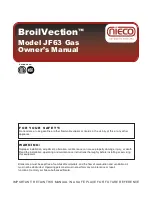
CONTROL PANEL OPERATING PROCEDURES
8/1/99
3-2
3.2 THE TEMPERATURE CONTROLLER
The temperature controller is a PID
programmable controller that utilizes feedback
information to accurately maintain a desired set
point. It is the primary source for programming
and viewing operating parameter settings. It
plays a part in the start sequence and includes
other features such as:
•
LED display
•
5 indicator status lights
•
3 menu levels
•
RS-485 communications capability
3.2.1 LED DISPLAY
The display consists of a two line, four character
seven segment LED’s, (see Fig. 3.2). When an
operating parameter is chosen to be changed or
looked at, the lower LED display indicates the
parameter being looked at in the form of a code.
The upper display indicates the parameter’s
value. For a complete listing of the operating
parameters see Appendix A of this manual.
3.2.2 INDICATOR STATUS LIGHTS
The first LED indicator light, “MAN” indicates
whether the controller is in auto or manual
mode, (see Fig 3.2). When lit, the controller is in
manual mode and the operator is responsible for
operation of the unit. When the LED is not lit, the
controller is in auto mode. In auto mode the
controller is operating the unit from signals
generated by sensors located on the unit or in
the system, or by signals from an energy
management system.
The second LED, “REM”, designates whether
the controller is being controlled locally or
remotely, (see Fig. 3.2). When lit the controller is
in remote mode and it can accept commands
from an external source. When this LED is not
lit, the controller is in local mode and it will
respond to its current internal settings are. All
external commands are ignored.
The third LED, “Demand for Heat " indicates
whether the temperature controller's internal
start relay is open or closed (see Fig. 3.2). The
start relay is part of the start sequence, closing
when the control signal reaches 25% or higher.
This lights the "Demand for Heat" LED and
begins the combustion process. The start relay
opens when the control signal is 19.9% or lower,
shutting the "Demand for Heat" LED and
stopping the combustion process.
The last two LED’s,
“
o
F” and “
o
C”,
indicate
whether the temperature displayed is
°
Fahrenheit or
°
Celsius, (see Fig. 3.2).
NOTE:
When the temperature controller is displaying in
o
C only the temperature being displayed is
affected. All other values remain in
o
F.
3.2
Temperature Controller Operating Status Lights
3.2.3 MENU LEVELS
The temperature controller has two menu levels
that are operator accessible for programming
the unit functions and parameters. These are the
Primary and Secondary menus:
To change from the primary menu to the
secondary menu, simultaneously depress the
arrow key and ENTER button. To change from
the secondary to the primary menu
simultaneously press the
⇓
arrow key and the
MENU button.
To scroll through a menu, depress the MENU
button. To change a parameter scroll through
the menu until the desired parameter is
indicated on the controller’s lower LED display.
Then use the
and
arrow keys to change the
parameters value. Once a parameter’s value
has been changed the ENTER key must be
depressed for the change to be recognized by
the controller. Leaving the desired parameter
without entering the new value will result in that
parameter value defaulting back to the previous
value. Detailed descriptions and instructions for
accessing each menu parameter are listed
within this section. For more data concerning the
minimum and maximum range, and factory
defaults of menu parameters, see Appendix E of
this manual. Each menu level is described
below.
Summary of Contents for Benchmark G-00-711
Page 62: ...APPENDIX C ix Temperature Sensor Resistance Chart Balco ...
Page 69: ...APPENDIX F xvi ...
Page 70: ...APPENDIX F xvii ...
Page 71: ...APPENDIX F xviii ...
Page 72: ...APPENDIX F xix ...
Page 73: ...APPENDIX F xx ...
Page 74: ...APPENDIX G xviii ...
Page 75: ...APPENDIX G xix ...
Page 76: ...APPENDIX H xxi ...
















































